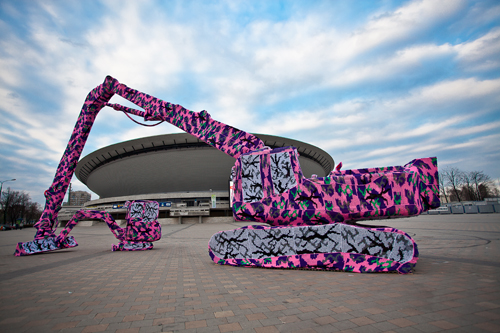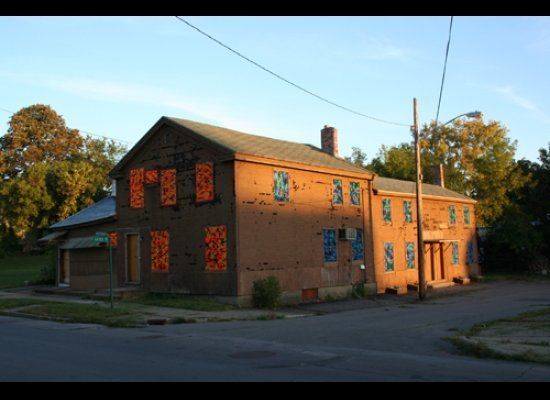
Image courtesy of the artist Olek
Olek, a Polish immigrant living in New York since 2003, takes common objects, text messages, public sculpture, construction equipment, and in fact anything that is a reflection of daily life, and transforms it with a covering of crocheted yarn. Sometimes confused with street art because of the element of secrecy and surprise (watch Olek cover the Wall Street Bull at 2 am), the truth is Olek is an artist whose work follows in the tradition of Marcel Duchamp, where daily devices we all interact with are transformed into art. The work is always very personal; Olek has transformed whole rooms of her personal effects, used break-up text messages from boyfriends and reinterpreted the art of other artists to make statements about our culture. All this while at the same time creating a very participatory experience for the onlooker. From gallery shows, to festivals, to the walkways under bridges, every place is a potential site for one of her installations.
Below Olek answers some questions I had for her about the meaning of her work.
TH: You've said that "life and art are inseparable." How do the objects you cover convey your internal world?
Olek: In July 2011 I was working around the clock for my first solo show at Jonathan Levine Gallery. My ex-boyfriend whom I was living with gave me his laptop to check my emails. I found out that he was writing to some girls off Craigslist. We broke up. I said nothing. Instead, when the time came, I crocheted the entire email (see pic) and it became the central piece in the show [titled] "I do not expect to be a mother, but I do expect to die alone" [at] Tony's Gallery in London in January 2012. Most men hated the show. Women thanked me for empowering them.
Life and art are inseparable. Anything that enters my life will be highlighted in crochet, either you like it or not.
TH: It's obvious that you create a three-way dialogue by covering public objects with brilliant colors, such as the Wall Street bull, bikes, and shopping carts. A conversation is inevitable between you the artist, the object covered with yarn, and not only the onlookers, but also the thousands of people that respond to the photographed images of your work. The bull was all over Facebook for days, maybe even weeks. Are you trying to stimulate any particular thought or dynamic or is it more haphazard, let the chips fall where they may, kind of thinking?
Olek: I believe that there are two objectives that should not direct the way you make art: money and public opinion. I believe in developing new ways of creating a dialogue with the viewer on both visual and aural levels. All of the five senses are heightened as the audience develops new means of interacting with the piece, realizing that their response greatly impacts the art and the ways these forms are moving over time. Their response is the art, and my work is a mirror.
TH: You've often talked about how you watch hours and hours of movies while you crochet. How do movies influence your thinking? When you see your finished pieces in the streets, do they remind you of the movies you watched while you worked? The way a song takes you to a particular time and place?
Olek: I choose crochet as my artistic method to be able to do at least two things at once: watch movies and make art... (well... I've accomplished more than being entertained by films while crocheting but I need a bottle of Polish vodka to talk about it.)
I started my film/art journey with writing my thesis entitled "Symbolism of Costumes in Films by Peter Greenaway." My search became the starting point in my own investigations... I actually understood it a couple of years ago when I re-read it. References to Vermeer, Velazquez.... Transforming old into new. The last movie I saw in 2000 before I escaped from Poland was"Blade Runner. In 2010, I created a piece influenced by this moving image. I covered a 16 mm film projector with the videotape of this movie while I was watching it on DVD. I was crocheting and crocheting, re-playing it as many times as it took me to finish the new skin for the ready-made.
The movies I watch while crocheting influence my work, and my work dictates the films I select. I crochet everything that enters my space. Sometimes it's a text message, a medical report, found objects...
I have seen many, many movies about and by artists from design to literature, to music, to muses and finally fine arts, street art included, of course; anything that I could put my hands on and had anything to do with art history, even if a recent one. I was really impressed with the information I gathered from Picasso and Braque Go to the Movies" directed by Arne Glimcher. Obviously they were influenced by Georges Méliès's magic tricks and the harmony of volume, line and color in Loie Fuller's performances. Among many talking heads, there is Scorsese, who stated: "Cubism was not a style. It was a revolution that instigated a profoundly radical change of form -- in fact a radical change of vision itself." Movies were the engine behind that revolution. I say, someone out there... Please make great movies and I will make an amazing art!
TH: I love this quote from you from the Street Art News interview; you say you are "aggressively reweaving the world as I see it." It's interesting because your preferred choice of material holds so many associations. The colors and patterns are punk, pop, and the material elicits warm and fuzzy feelings, yet you incorporate social messages and commentary. It's quite a mix for reworking the way we see things. I had a very middle-class upbringing and my mother used to crochet afghans for fun, in really boring colors. How did such a traditional medium become part of radical street art?
Olek: How does a thought/idea form itself? It is a response to information, images, words, food or lovers you had... conversations that flow through an individual's unconscious. It is collaboration between environment and time. Inspiration comes from real life like my camouflage pieces come to me from my own obsession of wearing different color camouflage pants. I wore camo pants the first time I came to the USA, and working with camo seemed like an extension of myself. I started crocheting, as I could not afford anything else. In 2002, I crocheted between trees because they were around me. I covered a stepladder because my ex-girlfriend had one and I was bored when she was working. Everything comes from real feelings and intuition. The public may not know the background story; they accept it or even love my work because it is honest. I hope.
Besides, I do not like be enclosed on one folder: street art. I do much more.
TH: You make sculpture, yet your work is very graphic and visually arresting. It seems like you are purposefully working in this space that is in between the two. Do you think that is part of the reason the public has taken to your work so well?
For me it is crucial to create pieces that work on two levels: the conceptual and the visual. The common passerby might see just the pink camo on the bull. But intellectually, we know the story and meaning behind the action. It relates to all my interventions.
TH: You are recycling many of the objects from your own personal life and environment. Is that incidental or do you mean to make some kind of environmental statement?
Olek: I think the first environmental artist was Rose Selavy. We live on a pile of garbage. I try not to create more. Maybe this is one of the reasons I cover what surrounds me. I started doing it when I was a child and I was forced to collect anything, even the tin bottle caps, to make my school project. Some things never change.
TH: Another aspect of your work that is interesting is that you use personal text messages in your work, sentences or phrases that would normally be deleted. You make them forever lasting by incorporating them into your work. Yet the bull was only covered for two hours before it was taken down, so other parts of your work was very much like a sand mandala, created for the sake of creation and then quickly destroyed without any attachment on your part. What is this dynamic of preservation and destruction that you are constantly exploring?
My new text-based work immortalizes the intense yet fleeting sentiments of modern relationships. By contrasting the convenience of "txt msgs" with the labor-intensiveness of crocheted sculpture, I transform a naturally guarded form of communication into declarations of truth and lies. These homemade pieces challenge the established barriers of privacy and tradition and re-examine modern communication technology.
The artwork is destroyed as it is created, and created out of its own destruction. Still and metamorphosing, old and new, unique and common, public and private, hidden and exposed, performer and creator, traditional and innovative, decay and renewal, are all interchangeable.
TH: Name an artist you'd like to be compared to.
I was recently called by Stylist magazine the "Tracey Emin of knitting." Well, I think "knitting is for pus****," but I still take this as a high compliment. I'd like to add Louise Bourgeois and Marina Abramovic. Their work, career path, and lives opened doors to an artist like Olek.
![]()
Image courtesy Olek
TH: Why do you make art historical references in your work? You've riffed on Banksy, Keith Haring, Duchamp and Picasso? Do you think the public gets it? Does it matter if they don't?
One might write a review, one might acquire my work. But even if I just see a smile on a person's face, my work is complete.
TH: In another interview you said, "Cocktails are for pussies, I drink vodka." Where do you get your vodka, any special recipes you want to reveal? Or are you just drinking it straight up?
More specifically, I drink Polish vodka! We have so many different kinds and each can be drunk in various ways. I like vodka soda when I am outside of Poland. In my native country I always experiment.
TH: What comes first in your work, pleasure or pain?
Pleasure and pain are twin sisters. The work comes from pleasure, the only pain I have is in my arms and hands. If it comes from pain, it is a cathartic experience that lets me to move on.
![]()
Image courtesy Olek
TH: What's the most important career break you ever got?
I am still waiting for one.
![]()
Image courtesy Olek
I am a visual artist and I chose it as my language. You can find the answers to all your questions in my work.
